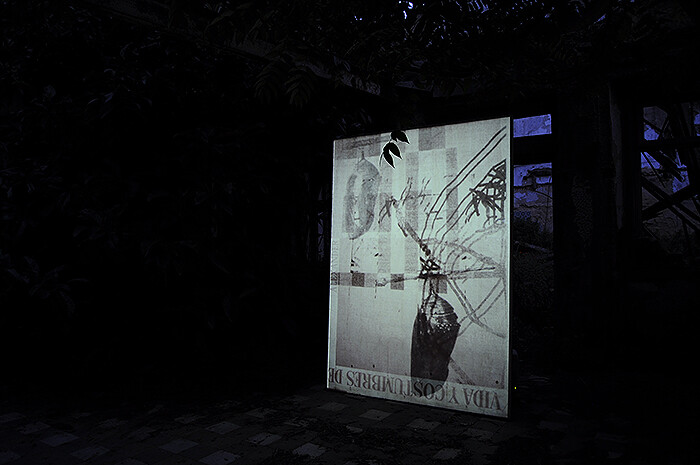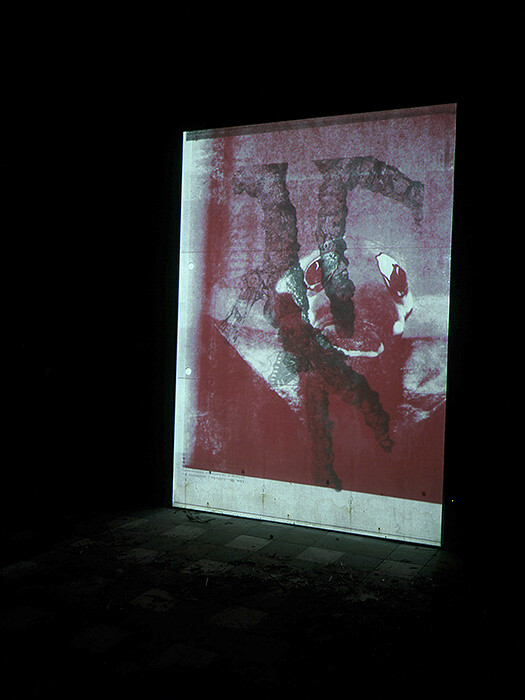Recurrent in Alexandre Estrela’s practice is the use of images from nature, as well as a consideration of the way in which they are transformed and questioned through the employment of various technologies of recording and reproduction, sometimes explored to the limits of legibility and denaturation. This is often achieved by the short-circuiting of cognitive processes and several displacements of meaning, which induce in the viewer a somewhat indefinable sensation of uncanniness, as well as a feeling of anxiety that arises from an underlying tension between the way technology is used and our perception, experience, and understanding of the work. Alongside the significant body of work he has developed since the early 1990s, during the past eight years Estrela has been running a nonprofit initiative called Oporto, which presents a regular and original program of rarely seen experimental cinema and video.
His new work, Vida y Costumbres de Alexander (2015) exemplifies the above-mentioned tension at play. A vertical glass screen leans against an outdoor wooden structure placed inside the ruins of a small, semi-derelict, roofless house on a patio behind the gallery. The surrounding space is mostly revealed by the light of this nocturnal piece, activated by a video projection in the dark. On the right side of the screen stands a large loquat tree, which is barely perceptible yet strangely menacing directly next to the structure. The bright light of the projection hits the screen frontally, obfuscating the viewer, who must move to the side of the glass in order to see the images that are being projected. The slightly tilted glass screen acts both as a transparent and reflective surface, mirroring a white trapeze onto the floor in an expanding geometry of light.
The video juxtaposes enlarged photocopied images combining multiple layers of prints. Images such as the ones taken from an entomology book on the life and habits of Lepidoptera blend with architectural drawings and sketches, with reproductions of Derek Jarman’s sculptures, and with the artist’s own children’s early drawings of a spider web, magnified in dark, large, and abstract lines sprawling across the screen. These still superimposed images are animated through slow dissolves, transitioning from one to the other and forming a continuous sequence repeated on a loop. Each dissolve creates even more layers of imagery, somewhat disturbing our understanding even further. A densely textural electronic music (an early 1970s feedback work of the French composer Éliane Radigue), emitted by an invisible source, fills the outdoor space in long, sustained cycles. Some of the images are reproduced as serigraphs at the entrance of the gallery.
The longer we look, the more is revealed to us. We can’t help feeling amazed by the marvels and horrors of magnification—monumental larvae, pupas, and adult moths blend with textured images tinted in red and black. The play of color in the same image creates an effect of depth and volume (Estrela calls it a failed attempt to make a hologram). Geological formations, surveying sketches, dark and shaky circular lines, and ink-smudged surfaces become an organic whole. In a particularly disturbing red-tinted image, an enormous ant mauls a caterpillar. In the same image, we perceive two hanging black-and-white pupas. A human head, beheaded or maybe impaled, shows up on the upper left side of the image, in what amounts to an unsettling moment among the various transformations we are witnessing.
The children’s drawings reveal an unstructured, early conception of the world. They are discontinuous, open; both a way of denaturing nature and a way to represent something that is not yet fully formed. They also suggest a transitioning process, a dissolve in itself, a moment before language.
The light of the object-screen allows us to discover the space, while the sound provides an aural density heightened by the imponderable intervention of the wind and the rustling tree. The images and sounds become arrested in their own artifice within an endless extended and perpetual slow mutation which mirrors their own subjectivity—nature mutating within nature, nature transformed, not-yet formed things. Time, images, the music, and the natural elements of the space shift slowly in repeating cycles.
As subjective as it may be, the choice of imagery is certainly purposeful even if the outcome of its combinations is indeterminate and experimental. The magnification of the images and the use of the dissolves become the structuring form of the work. Instead of harmony, they are used to expose an underlying vulnerability—also a defining trait of Alexandre Estrela’s work and his ongoing research on the mechanisms of perception.









